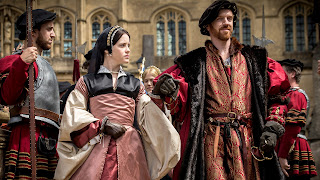Many of us who love historical costume were completely smitten with the production shots we saw before Wolf Hall aired earlier this year. Now the series is available for sale through PBS, BBC, and even national retailers like Target. With the popularity of this series I want to take a moment and give those new to Tudor fashions a few notes before you take everything in the series as gospel. This is one of the most accurately costumed historical dramas that I have seen in years. The color palate, cuts, underwear, and fabrics are impeccable. But don't forget to do your own research into the clothing as you make your own ensembles.
Odd Piece #1: French Hoods
Odd Piece #2: Infamous Cod Pieces
Odd Piece #3 Wrinkled bodices.
Great thing #1: Men have correct hats!
Great thing #2 Jewelry!
Great thing #3 Middle Class Clothing!
Great thing #4 Table manners
Great thing #5 Pregnancy Clothing
Odd Piece #1: French Hoods
- I appreciate the costume designer here for acknowledging French hoods need veils. I doubt though that you will find a single portrait from the 1520's or 30's in England or France that uses fine silk chiffon. Typically you will see a solid black veil on the French and English hoods. Medals done in profile from the time period and illuminated manuscripts also suggest these are hats, not pretty head bands.
Odd Piece #2: Infamous Cod Pieces
- The internet was a buzz with interviews from the cast and production team about these being a choice. Yes the cod pieces in period were larger, but the designer didn't want to distract from the story. Modern audiences just can't seem to handle a good cod piece.
Odd Piece #3 Wrinkled bodices.
- Several of the productions shots on Anne's airy silk gowns that were build for Claire Foy show wrinkles across the front of the bodices. It does create a fun visual with the light playing with the fabric, but is not historically accurate. I have had this happen even with velvet if I don't use enough tension and pins on my placards. Practice makes perfect!
Great thing #1: Men have correct hats!
- All of the men have beautiful hats. The designers put so much energy into sewing , knitting, or felting these hats from the correct materials they add a new dimension of texture to the screen. check out all of the different shapes which are specific to clergy, scholars, nobility, common people. The range is also stunning.
Great thing #2 Jewelry!
- Many of these pieces were researched to extremes, and then used appropriately. Jewelry wasn't just thrown on anyone of rank to make them look wealthy. The designer uses it for impact and with class. The jewelry also has the correct styles for the period instead of being modern baroque jewelry from a costume jewelry shop. (Anne Boleyn still shouldn't be wearing earrings based on my research, but at least these are tasteful drop pearls typically.)
Great thing #3 Middle Class Clothing!
- Very few productions show middle class clothing without disappearing into ren faire stereotypes. Thank you for doing research and even setting the primary styles of clothing on the middling sort back 10 years from the royal court, and in correct fabrics. Elizabeth Cromwell's costumes are actually my favorite of the whole production!
Great thing #4 Table manners
- The actors and directors added a fun Easter egg into their stage business for well researched individuals. Take a gander at their table manners. Napkins are not in their laps but on shoulders or other easy to reach places and there are very few forks floating around.
Great thing #5 Pregnancy Clothing
- Woman of the time did not have clothing they only wore for pregnancy. There are styles that are more comfortable than others women may gravitate to, but most of the accommodations for the growing belly were done by lacing a garment looser, adding placards for modesty, or altering clothing. Anne's coronation scene shows her very pregnant, which is consistent with historical accounts. Rather than wearing a tent to hide the baby bump it is triumphantly displayed and the gown is pinned to the kirtle with a gap. Bravo!
Great thing #6 Pins
- For ease of use there are so many times small details are over looked. Dressing pins are an essential part of the Tudor wardrobe. Everyone used them and they used them by the pound each year. Rather than stitching turn backed sleeves into place or solely wiring bonnets the wardrobe crew used period appropriate dressing pins. Thank you! I noticed and I appreciate it so much!
Conclusions:
I love this mini series and can't wait for season 2 to hit the small screens. The research in the fine details shows through on the costumes and accessories. I will always encourage people to do their own research before hopping in to build one of these ensembles. This is one of the most historically accurate dramas for this period I have seen in many years, so if you need cinematic inspiration please do start here!








Comments
Post a Comment